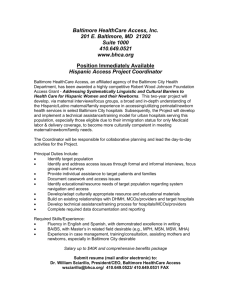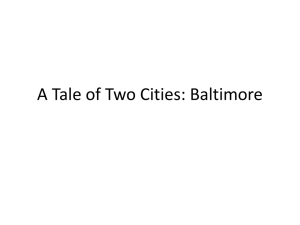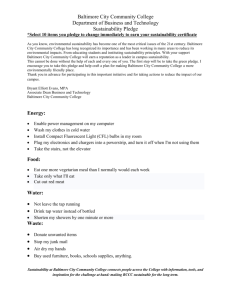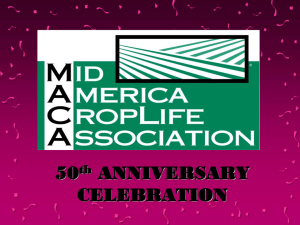Learning to Translate Art into the Language of Community
advertisement
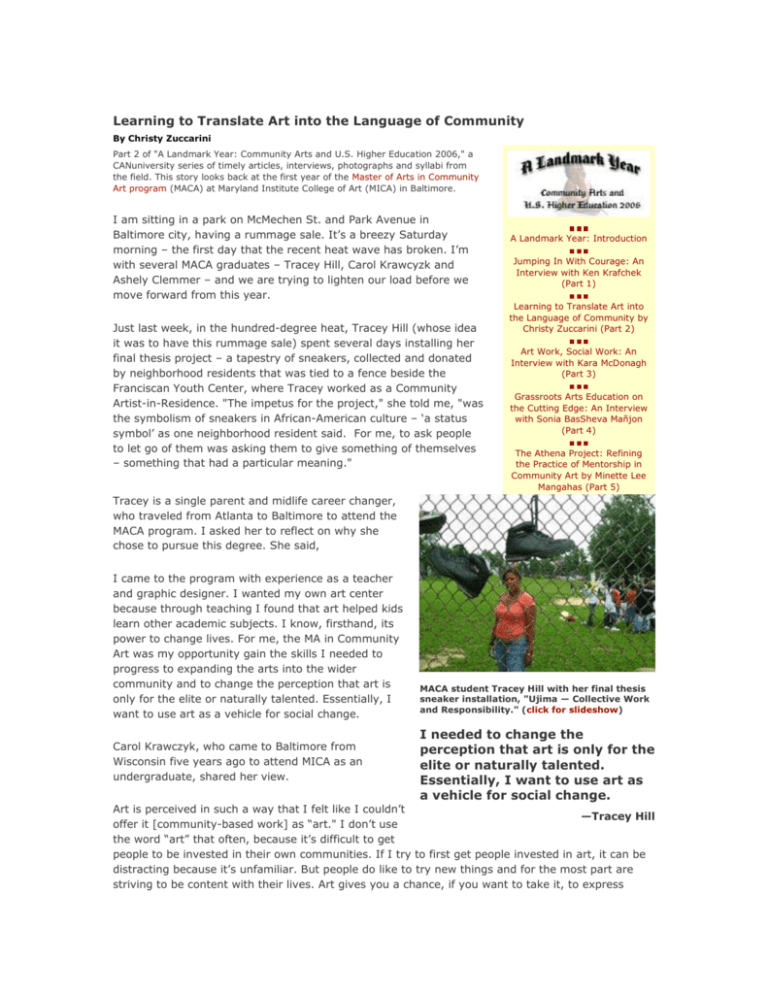
Learning to Translate Art into the Language of Community By Christy Zuccarini Part 2 of "A Landmark Year: Community Arts and U.S. Higher Education 2006," a CANuniversity series of timely articles, interviews, photographs and syllabi from the field. This story looks back at the first year of the Master of Arts in Community Art program (MACA) at Maryland Institute College of Art (MICA) in Baltimore. I am sitting in a park on McMechen St. and Park Avenue in Baltimore city, having a rummage sale. It’s a breezy Saturday morning – the first day that the recent heat wave has broken. I’m with several MACA graduates – Tracey Hill, Carol Krawcyzk and Ashely Clemmer – and we are trying to lighten our load before we move forward from this year. Just last week, in the hundred-degree heat, Tracey Hill (whose idea it was to have this rummage sale) spent several days installing her final thesis project – a tapestry of sneakers, collected and donated by neighborhood residents that was tied to a fence beside the Franciscan Youth Center, where Tracey worked as a Community Artist-in-Residence. "The impetus for the project," she told me, "was the symbolism of sneakers in African-American culture – ‘a status symbol’ as one neighborhood resident said. For me, to ask people to let go of them was asking them to give something of themselves – something that had a particular meaning." Tracey is a single parent and midlife career changer, who traveled from Atlanta to Baltimore to attend the MACA program. I asked her to reflect on why she chose to pursue this degree. She said, I came to the program with experience as a teacher and graphic designer. I wanted my own art center because through teaching I found that art helped kids learn other academic subjects. I know, firsthand, its power to change lives. For me, the MA in Community Art was my opportunity gain the skills I needed to progress to expanding the arts into the wider community and to change the perception that art is only for the elite or naturally talented. Essentially, I want to use art as a vehicle for social change. Carol Krawczyk, who came to Baltimore from Wisconsin five years ago to attend MICA as an undergraduate, shared her view. A Landmark Year: Introduction Jumping In With Courage: An Interview with Ken Krafchek (Part 1) Learning to Translate Art into the Language of Community by Christy Zuccarini (Part 2) Art Work, Social Work: An Interview with Kara McDonagh (Part 3) Grassroots Arts Education on the Cutting Edge: An Interview with Sonia BasSheva Mañjon (Part 4) The Athena Project: Refining the Practice of Mentorship in Community Art by Minette Lee Mangahas (Part 5) Valuing Public Scholarship: An Interview with Doug Blandy (Part 6) Third Space: Youth, Arts and Community Development by Lori Hager (Part 7) MACA student Tracey Hill with her final thesis sneaker installation, "Ujima — Collective Work and Responsibility." (click for slideshow) I needed to change the perception that art is only for the elite or naturally talented. Essentially, I want to use art as a vehicle for social change. Art is perceived in such a way that I felt like I couldn’t —Tracey Hill offer it [community-based work] as “art." I don’t use the word “art” that often, because it’s difficult to get people to be invested in their own communities. If I try to first get people invested in art, it can be distracting because it’s unfamiliar. But people do like to try new things and for the most part are striving to be content with their lives. Art gives you a chance, if you want to take it, to express yourself and your perspective. So often, that opportunity is not given. That’s why I think that art can be a powerful tool that helps people talk to themselves first and then to others and begin to build a community where they collectively realize their power and work together. This year, Carol worked as a Community Artist-in-Residence in Curtis Bay, which is the southernmost neighborhood of Baltimore city. Located on the water, Curtis Bay is surrounded by incinerators and power plants and has the 11th worst toxic air pollution in the country. Carol used photography, sketching and journaling as a way for the residents of Curtis Bay to document their neighborhood in an effort to begin building a sense of community there. “We have built a small team of people who are ready to work together and make things happen," Carol says. "Something is now there that wasn’t there before.” Art gives you a chance, if you want to take it, to express yourself and your perspective. So often, that opportunity is not given. —Carol Krawczyk We all agreed that perception – be it of art or of certain individuals or places – dictates much of what we do as community artists. During my year in the MACA program, I was the Community Artist-in-Residence for the Youth Dreamers, a youth-run nonprofit organization whose mission is to decrease the amount violence involving youth after school. When I began my residency, the Youth Dreamers had just purchased a vacant house in the community they serve. Their plan was to renovate and turn it into a youth-run youth center. Upon their purchase, the Youth Dreamers were confronted with opposition from the residents surrounding the house – mostly older adults – whose objections to a youth center included fears that such a place would only invite violence to their neighborhood. The Youth Dreamers and I worked collaboratively to determine how we could use art to reach out to those neighbors and change their perception of youth. They held block parties, led after-school art classes, took photographs of their own lives and contributed their work to public art exhibitions. Relations between these young people and their neighbors have begun to mend but the process has been a slow one. However, these experiences helped the Youth Dreamers to develop their own infrastructure for community outreach and their goal is to continue utilizing art as a vehicle for outreach once their youth center is fully renovated and ready to open. During our residencies, each of us found a way to translate art into the language of community and to initiate projects and programs that were and still are community-driven. Ashley Clemmer worked at the Creative Alliance, a nonprofit, multipurpose art center located in a historic movie theater in Southeast Baltimore. Her role as a community artist involved program development and planning community events in an effort to offer the Alliance as a resource to the diverse communities that surround it. During our residencies, each of us found a way to translate art into the language of community and to initiate projects and programs that were and still are communitydriven. Ashley recognized that among the Polish, Lithuanian, Hispanic, Greek and Italian communities of Southeast Baltimore, the art of cuisine was a commonality. She began to build a rapport with local restaurant owners who invited her into their kitchens and shared with her the intricacies of their cuisine and its significance in their culture. In response, she organized a public event that celebrated cooking across cultures. Members from each community were invited to demonstrate the creation of certain dishes and share recipes with one another. The resulting dialogue was unprecedented for the Creative Alliance and the community and will perhaps spark a new tradition there. At a recent art exhibition entitled “Collective Spirit: A Celebration of Community Arts in Baltimore,” MACA students showed much of the work that was made during their residencies in community. The exhibition was held at Maryland Institute to highlight the Community Art Corps (CAC) program – an AmeriCorps-sponsored community-service initiative that seeks to engage Baltimore communities in meaningful art experiences. Part of what makes MACA unique is that it offers its students the opportunity to enroll in this AmeriCorps program and receive a living stipend and education award for their service to the community. At the exhibition’s opening, community members came to see their efforts honored as well as to share their art experiences with one another. The work on display marked a significant milestone in our year in MACA because it embodied the power that comes from meaningful relationships and collaborative endeavors. Some of us will stay and work in the communities we’ve come to know People seem to and others will move on to different places. Carol is headed for Nicaragua, be more inclined where for one month she and several MACA students and Baltimore City to find ways that high-school students will participate in the Bridges to Community program. they are different Carol has also applied for an Open Society Institute fellowship so that she instead of ways can continue to work in Curtis Bay. “I went into the community and started meeting people," she says, "and it took me a while to meet people they are the same and that’s who shared my vision. I feel like we’ve built a lot but it isn’t enough and I’m afraid that if I leave, the momentum will fizzle; that the efforts won’t why I think be sustainable.” Tracey recently submitted a grant proposal to support community art is Community Art programming at the Franciscan Youth Center, where she important in could continue to work, although she is open to going anywhere. I have every secured a position in development at a local nonprofit organization here in community. Baltimore. And, in several weeks, Ashley and her husband will be moving —Ashley Clemmer to Houston. “Right now, I want to continue doing program development and event planning,” she says. “People seem to be more inclined to find ways that they are different instead of ways they are the same and that’s why I think community art is important in every community. I think I can find a way to do it anywhere I go.” Christy Zuccarini received her undergraduate degree in Cultural Anthropology and Photography from Goucher College. She was a VISTA volunteer in Southeastern Oklahoma and Baltimore City before enrolling in the MACA program, from which she graduated in 2006. Original CAN/API publication: September 2006


